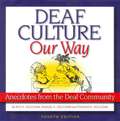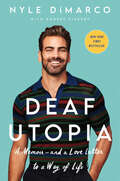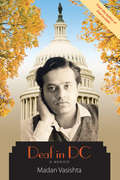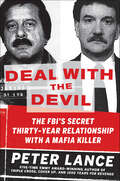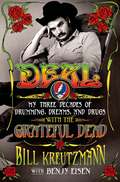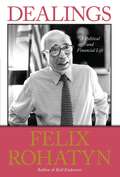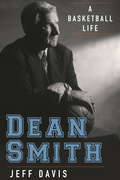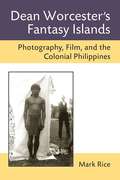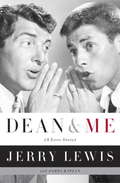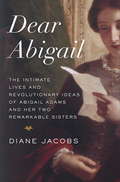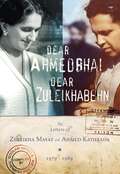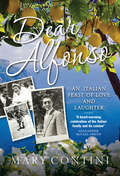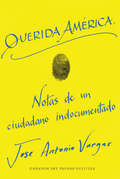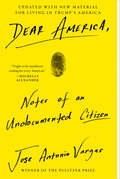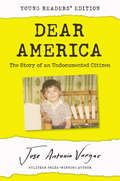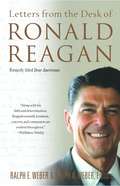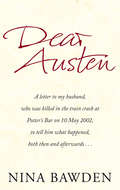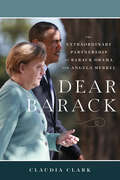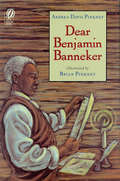- Table View
- List View
Deaf Culture Our Way: Anecdotes from the Deaf Community
by Thomas K. Holcomb Roy K. Holcomb Samuel K. HolcombUsing humorous stories with illustrations, this classic collection brings deaf culture to life through personal experiences and practical day-to-day information. Various aspects of the deaf world are illuminated through anecdotes, updated in this edition to include new stories about the foibles of the latest communication technologies, including VRS, videophones, email, and instant messaging. Also provided is classroom material for teachers that can be used as excellent supplemental reading for deaf studies, ASL, or interpreting classes, as well as a springboard for discussions about deaf culture.
Deaf Utopia: A Memoir—and a Love Letter to a Way of Life
by Nyle DiMarco Robert SiebertA heartfelt and inspiring memoir and celebration of Deaf culture by Nyle DiMarco, actor, producer, two-time reality show winner, and cultural icon of the international Deaf communityBefore becoming the actor, producer, advocate, and model that people know today, Nyle DiMarco was half of a pair of Deaf twins born to a multi-generational Deaf family in Queens, New York. At the hospital one day after he was born, Nyle “failed” his first test—a hearing test—to the joy and excitement of his parents.In this engrossing memoir, Nyle shares stories, both heartbreaking and humorous, of what it means to navigate a world built for hearing people. From growing up in a rough-and-tumble childhood in Queens with his big and loving Italian-American family to where he is now, Nyle has always been driven to explore beyond the boundaries given him. A college math major and athlete at Gallaudet—the famed university for the Deaf in Washington, DC—Nyle was drawn as a young man to acting, and dove headfirst into the reality show competitions America’s Next Top Model and Dancing with the Stars—ultimately winning both competitions.Deaf Utopia is more than a memoir, it is a cultural anthem—a proud and defiant song of Deaf culture and a love letter to American Sign Language, Nyle’s primary language. Through his stories and those of his Deaf brothers, parents, and grandparents, Nyle opens many windows into the Deaf experience.Deaf Utopia is intimate, suspenseful, hilarious, eye-opening, and smart—both a memoir and a celebration of what makes Deaf culture unique and beautiful.
Deaf in DC: A Memoir
by Madan VasishtaIn his first memoir, Madan Vasishta described being a deaf boy in his homeland India, where "deaf" meant someone who is not human. After rising from herding cattle to being a respected photographer in Delhi, his first memoir concluded with his acceptance at Gallaudet College far away in America. Vasishta's new memoir begins with his arrival in Washington, DC in 1967 with $40.00 in his pocket and very little knowledge of the new worlds he was entering. Vasishta faced myriad challenges from the outset-- he knew no American Sign Language and could not speech read, yet he found himself thrust into classes at Gallaudet two weeks into the semester. Cultural differences mystified him, such as how all American car accidents were someone else's fault even when one's car hits a stationary object. He was amazed that his fellow students did not deride him for his mistakes, unlike in India where he would have been scorned for his weakness. After five years, he returned home to India for a visit and was stunned to learn that he no longer fit in, that "even if you do not have an American Dream, the American Dream will have you." Deaf in DC follows Vasishta through half a century living in America. He witnessed the transformation from facing bias as a deaf, foreign man of color who could not get a job despite having a Ph.D., to receiving five offers as a school superintendent in the wake of the Civil Rights movement and Deaf President Now. His new memoir reflects a genuine worldview informed by the sage perceptions of a person who has lived widely in many worlds.
Deal with the Devil: The FBI's Secret Thirty-Year Relationship with a Mafia Killer
by Peter LanceIn Deal with the Devil, five-time Emmy Award–winning investigative reporter Peter Lance draws on three decades of once-secret FBI files to tell the definitive story of Greg Scarpa Sr., a Mafia capo who “stopped counting” after fifty murders, while secretly betraying the Colombo crime family as a Top Echelon FBI informant.Lance traces Scarpa’s shadowy relationship with the FBI all the way back to 1960, when his debriefings went straight to J. Edgar Hoover. In forty-two years of murder and racketeering, Scarpa served only thirty days in jail thanks to his secret relationship with the Feds. This is the untold story that will rewrite Mafia history as we know it —a page-turning work of journalism that reads like a Scorsese film. Deal with the Devil includes more than 130 illustrations, crime scene photos, and never-before-seen FBI documents.
Deal: My Three Decades of Drumming Dreams and Drugs with the Grateful Dead
by Bill Kreutzmann Benjy EisenThe Grateful Dead are perhaps the most legendary American rock band of all time. For thirty years, beginning in the hippie scene of San Francisco in 1965, they were a musical institution, the original jam band that broke new ground in so many ways. From the music to their live concert sound systems and fan recordings, they were forward-thinking champions of artistic control and outlaw artists who marched to the beat of their own drums.<P><P> Bill Kreutzmann, one of their founding members and drummer for every one of their over 2,300 concerts has written an unflinching and wild account of playing in the greatest improvisational band of all time. Everything a rock music fan would expect is here, but what sets this apart is Bill's incredible life of adventure that was at the heart of the Grateful Dead experience. This was a band that knew no limits and Bill lived life to the fullest, pushing the boundaries of drugs, drums and high times, through devastating tragedy and remarkable triumph.<P> But at this book's beating heart is the music--theirs and others. Some of the greatest musicians and concerts were a part of the Grateful Dead's career, from sharing the stage with Janis Joplin, Bob Dylan, and The Who, to playing in the Acid Tests, The Monterey Pop Festival, Woodstock and Altamont. Bill's life is a chronicle of American music and pop culture history and his epic personal journey is one of sonic discovery and thrilling experiences.
Dealings: A Political and Financial Life
by Felix G. RohatynIt was a German soldier’s chance decision to reach for a cigarette and absently wave a car through a checkpoint outside Marseille in 1940 that allowed Felix Rohatyn and his Jewish family to escape from Nazi-occupied France. In the States, a chance summer job led him to the small, private investment bank of Lazard Frères, where he came under the tutelage of legendary financier André Meyer. The summer job turned into an extraordinary fifty-year career. Hailed as "the preeminent investment banker of his generation," Rohatyn was a creator of the merger-and-acquisition business that revolutionized investment banking and transformed the worlds of finance and entertainment. In this very personal account, Rohatyn takes us behind the headlines to offer readers a telling look at some of the era’s most renowned figures in the worlds of finance, entertainment, and politics. We are alongside Rohatyn as he meets Steve Ross in the back of the funeral parlor Ross is managing as they strategize to take control of Warner Brothers, and in André Meyer’s art-filled apartment as they negotiate with Frank Sinatra. We are with Rohatyn as he assists Harold Geneen of ITT weather a series of congressional investigations, and as he stays one step ahead of the canny Michael Ovitz as Matsushita attempts to win control of Lew Wasserman’s Universal Pictures. We also watch Rohatyn defending shareholders’ interests as the RJR-Nabisco buyout becomes a cautionary tale of executive greed. We have a front-row seat as Rohatyn and Governor Hugh Carey forge a desperation plan to save New York City from bankruptcy. And we accompany Rohatyn when he returns to Paris as the U.S. ambassador to the country he barely escaped alive as a young boy. Full of headline-making revelations, insider stories, keen personal observations, and relevant financial wisdoms, Dealings is the page-turning story of a life well lived.
Dean Smith: A Basketball Life
by Jeff Davis"Other than my parents, no one had a bigger influence on my life than Coach Smith. He was more than a coach—he was my mentor, my teacher, my second father. Coach was always there for me whenever I needed him and I loved him for it. In teaching me the game of basketball, he taught me about life."—Michael JordanFormer University of North Carolina men’s basketball coach Dean Smith was one of the most successful coaches ever to hold a whistle. In his 36 years at North Carolina, his teams won a record 879 games. They also captured 17 conference championships and two NCAA championships, claimed 30 seasons with at least 20 wins, and made 11 Final Four appearances. Coach Smith developed 26 consensus All-Americans, five NBA rookies of the year (including the great Michael Jordan), and 25 first-round draft picks.But Smith’s basketball accomplishments tell only part of his story. You may not know that Smith worked to abolish the death penalty in North Carolina and openly supported gay rights. As a high school senior in 1949, five years before the Supreme Court’s historic ruling in Brown vs. Board of Education, he pleaded in vain with officials to include African-American players on the school’s basketball team. Sixteen years later, after completing his fourth season as the head coach at North Carolina, Smith ventured to New York City and came back to Chapel Hill with Charlie Scott, the most significant recruit of his tenure. Scott became the school’s first African-American scholarship recipient. Smith had successfully integrated major college basketball in the South.Smith passed away in February 2015, and Dean Smith: A Basketball Life takes stock of this extraordinary man whose ideas and philosophies have shaped the best of what college basketball has been and should aspire to be in the future. In this revealing biography, author Jeff Davis calls on the reminiscences of Coach Smith’s closest friends and associates, former players, coaches, and rivals, and a wealth of secondary sources, to render a rich and vivid portrait of this towering figure of 20th-century American sports.
Dean Worcester's Fantasy Islands: Photography, Film, And The Colonial Philippines
by Mark RiceDean Worcester’s Fantasy Islands brings to life one of the most significant (but under examined) figures in the history of U. S. colonialism in the Philippines. Upon the outbreak of the Spanish-American War, Worcester, a scientist who had traveled twice to the Philippines on zoological expeditions, established himself as one of America’s leading experts on the Philippines. Over a fourteen-year career as a member of the U. S. colonial regime, Worcester devoted much of his time and energy to traveling among and photographing non-Christian minority groups in the Philippines. He amassed an archive of several thousand photographs taken by him or by government photographers. Worcester deployed those photographs in books, magazine articles, and lectures to promote his belief that the United States should maintain control of the Philippines for decades to come. While many historians have examined American colonial photography in the Philippines, this book is the first lengthy treatment of Worcester’s role in shaping American perceptions of the Philippines in the early twentieth century.
Dean and Me
by James Kaplan Jerry LewisThey were the unlikeliest of pairs--a handsome crooner and a skinny monkey, an Italian from Steubenville, Ohio, and a Jew from Newark, N.J.. Before they teamed up, Dean Martin seemed destined for a mediocre career as a nightclub singer, and Jerry Lewis was dressing up as Carmen Miranda and miming records on stage. But the moment they got together, something clicked--something miraculous--and audiences saw it at once. Before long, they were as big as Elvis or the Beatles would be after them, creating hysteria wherever they went and grabbing an unprecedented hold over every entertainment outlet of the era: radio, television, movies, stage shows, and nightclubs. Martin and Lewis were a national craze, an American institution. The millions (and the women) flowed in, seemingly without end--and then, on July 24, 1956, ten years from the day when the two men joined forces, it all ended. After that traumatic day, the two wouldn't speak again for twenty years. And while both went on to forge triumphant individual careers--Martin as a movie and television star, recording artist, and nightclub luminary (and charter member of the Rat Pack); Lewis as the groundbreaking writer, producer, director, and star of a series of hugely successful movie comedies--their parting left a hole in the national psyche, as well as in each man's heart.In a memoir by turns moving, tragic, and hilarious, Jerry Lewis recounts with crystal clarity every step of a fifty-year friendship, from the springtime, 1945 afternoon when the two vibrant young performers destined to conquer the world together met on Broadway and Fifty-fourth Street, to their tragic final encounter in the 1990s, when Lewis and his wife ran into Dean Martin, a broken and haunted old man.In Dean & Me, Jerry Lewis makes a convincing case for Dean Martin as one of the great--and most underrated--comic talents of our era. But what comes across most powerfully in this definitive memoir is the depth of love Lewis felt, and still feels, for his partner, and which his partner felt for him: truly a love to last for all time.
Dean and Me: A Love Story
by James Kaplan Jerry LewisBefore the string of hit songs, the Rat Pack, and the stellar movie career, Dean Martin spent ten years partnering Jerry Lewis in one of the most successful double acts of show business history. In this wise-cracking yet candid memoir, Lewis recalls with crystal clarity the highs and lows of his relationship with Dean: remembering their first meeting on a New York street corner one spring afternoon, the early improvised performances in mob owned nightclubs, and the giddy days of Hollywood super-stardom, when it seemed the couples high-rolling lifestyle would last for ever. It didn't. On July 24th 1956, Dean and Jerry split and the two men weren't to speak to one another for twenty years. Jerry Lewis is one of the few surviving Hollywood legends from the period and he is a wonderful raconteur whose tales reveal much about Dean Martin's craftsmanship and enigmatic charm. In his own unique voice he evokes all the glamour of the era - the casinos, the endless pranks, the cocktails, the mobsters, and the women. He writes movingly too of the thrill of the youthful duo's sudden, startling success, and the slow sad erosion of the fun that followed.
Dear Abigail: The Intimate Lives and Revolutionary Ideas of Abigail Adams and Her Two Remarkable Sisters
by Diane JacobsFor readers of the historical works of Robert K. Massie, David McCulough, and Alison Weir comes the first biography on the life of Abigail Adams and her sisters. "Never sisters loved each other better than we."--Abigail Adams in a letter to her sister Mary, June 1776 Much has been written about the enduring marriage of President John Adams and his wife, Abigail. But few know of the equally strong bond Abigail shared with her sisters, Mary Cranch and Elizabeth Shaw Peabody, accomplished women in their own right. Now acclaimed biographer Diane Jacobs reveals their moving story, which unfolds against the stunning backdrop of America in its transformative colonial years. Abigail, Mary, and Elizabeth Smith grew up in Weymouth, Massachusetts, the close-knit daughters of a minister and his wife. When the sisters moved away from one another, they relied on near-constant letters--from what John Adams called their "elegant pen"--to buoy them through pregnancies, illnesses, grief, political upheaval, and, for Abigail, life in the White House. Infusing her writing with rich historical perspective and detail, Jacobs offers fascinating insight into these progressive women's lives: oldest sister Mary, who became de facto mayor of her small village; youngest sister Betsy, an aspiring writer who, along with her husband, founded the second coeducational school in the United States; and middle child Abigail, who years before becoming First Lady ran the family farm while her husband served in the Continental Congress, first in Philadelphia, and was then sent to France and England, where she joined him at last. This engaging narrative traces the sisters' lives from their childhood sibling rivalries to their eyewitness roles during the American Revolution and their adulthood as outspoken wives and mothers. They were women ahead of their time who believed in intellectual and educational equality between the sexes. Drawing from newly discovered correspondence, never-before-published diaries, and archival research, Dear Abigail is a fascinating front-row seat to history--and to the lives of three exceptional women who were influential during a time when our nation's democracy was just taking hold.Advance praise for Dear Abigail "In a beautifully wrought narrative, Diane Jacobs has brought the high-spirited, hyperarticulate Smith sisters, and the early years of the American republic, to rich, luminous life. . . . A stunning, sensitive work of history."--Stacy Schiff, Pulitzer Prize-winning author of Cleopatra "Jacobs is a superb storyteller. In this sweeping narrative about family and friendship during the American Revolution, Abigail Adams emerges as one of the great political heroines of the eighteenth century. I fell in love with her all over again."--Amanda Foreman, New York Times bestselling author of A World on Fire "Beauty, brains, and breeding--Elizabeth, Abigail, and Mary had them all. This absorbing history shows how these close-knit and well-educated daughters of colonial America become women of influence in the newly begotten United States. Jacobs's feel for the period is confident; so is her appreciation of the nuances of character."--Daniel Mark Epstein, author of The Lincolns: Portrait of a MarriageFrom the Hardcover edition.
Dear Ahmedbhai,Dear Zuleikhabehn: The Letters Of Zuleikha Mayat And Ahmed Kathrada, 1979-1989
by Goolam Vahed Thembisa Waetjen‘The very sense of loss keeps alive an expectation. How easy it is to lose sight of what is historically invisible – as if people lived only history and nothing else!’
Dear Alfonso: An Italian Feast of Love and Laughter
by Mary Contini&“A heart-warming celebration of the Italian family and its cuisine&” from the bestselling author of Valvona & Crolla: A Year at an Italian Table (Alexander McCall Smith). Following the successful publication of Dear Francesca and Dear Olivia, bestselling author Mary Contini picks up the thread of her family story from 1934 in Pozzuoli, Naples, following the commercial success of the family business—Edinburgh&’s acclaimed delicatessen, Valvona & Crolla—and the Dolce Vita of her parent&’s generation. With her inimitable style she shares stories of exuberant family relationships, mouthwatering food and hilarious laughter, painting a vivid picture of life in wartime Italy and Scotland and the decades immediately after. &“Food is everywhere in the book, and it will be a stoic reader who doesn&’t fall upon the recipes at the back from Carlo&’s mother&’s kitchen.&” —The Scotsman &“Food is never far from Mary Contini&’s heart and storytelling . . . may be the perfect holiday read—upbeat, sunny, and easy reading . . . as an evocation of a time long past it&’s deftly written, tender, and true.&” —The Wee Review Praise for Dear Francesca and Dear Olivia &“Touching and inspiring . . . The book bursts with flavor.&” —Financial Times &“A remarkable book . . . a pleasure to read as well as to cook from.&” —Homes & Gardens &“Uplifts and inspires . . . Contini has augmented the family legends with historical research and imagination.&” —Sunday Times &“An enchanting, delectable read.&” —Sainsbury&’s Magazine &“Don&’t miss it: there won&’t be a better cookbook published this decade.&” —Elisabeth Luard, author of The Old World Kitchen
Dear Ally, How Do You Write a Book?
by Ally CarterFrom bestselling author Ally Carter, the definitive guide to writing a novel for the NaNoRiMo generation, including helpful tips from other YA stars.Have you always wanted to write a book, but don't know where to start? Or maybe you're really great at writing the first few chapters . . . but you never quite make it to the end? Or do you finally have a finished manuscript, but you're not sure what to do next? Fear not -- if you have writing-related questions, this book has answers! Whether you're writing for fun or to build a career, bestselling author Ally Carter is ready to help you make your work shine. With honesty, encouragement, and humor, Ally's ready here to answer the questions that writers struggle with the most.Filled with practical tips and helpful advice, Dear Ally is a treasure for aspiring writers at any stage of their careers. It offers a behind-the-scenes look at how books get made, from idea to publication, and gives you insight into the writing processes of some of the biggest and most talented YA authors writing today.
Dear Alyne: My Years as a Married Virgin
by Alyne TamirFrom world traveler, entrepreneur, and content creator @DearAlyne, a vulnerable and hilarious memoir of how she escaped the restrictive expectations of her family and faith and found herself in the process.Alyne Tamir was raised to live her life for others: for her husband, her family, and the Mormon church. For twenty-five years, she put them ahead of herself, repressing things that didn’t fit the neat, traditional story that had been written for her. On the surface, her life seemed picture-perfect. But in reality, Alyne was miserable, struggling to reconcile her flawless image with the pain and humiliation of abuse, an eating disorder, infidelity, and depression.Until Alyne reached a breaking point: the day her husband asked for a divorce—over email. Thank God! Or, not God. Finally free from the expectations of her family and faith, Alyne had to start a new life, which meant rediscovering herself and what she secretly wanted all along: the liberating life of a digital nomad.In a singular voice brimming with honesty and humor, Alyne invites us on a journey of strength and self-discovery—with a little bit of irreverence along the way. Dear Alyne is a one-of-a-kind, coming-of-age story and a testament to the limitless possibilities that await those brave enough to defy convention.
Dear America \ Querida America (Spanish edition)
by Jose Vargas"Fascinante y valiente. Este libro de memorias debe ser lectura obligatoria para todos". —Michelle Alexander, autora de The New Jim Crow, bestseller de The New York Times."Lloré leyendo este libro, comprendí plenamente lo que mis padres tuvieron que aguantar". —Amy Tan, autora de Club de la Buena Estrella, bestseller de The New York Times “Este libro no puede ser más relevante y necesario.” —Dave Eggers, autor de El Círculo El periodista Jose Antonio Vargas, ganador del Premio Pulitzer y “el inmigrante indocumentado más conocido de los Estados Unidos,” aborda una de las cuestiones más urgentes de nuestro tiempo en este libro explosivo y profundamente personal.Natural de Filipinas, Vargas fue llevado ilegalmente a los Estados Unidos cuando tenía 12 años. Durante más de dos décadas, vivió oculto de todos, logrando escribir para algunos de las publicaciones más prestigiosas de EE. UU., como The Washington Post y The New Yorker. Pero en 2011, Vargas reveló públicamente su estatus de indocumentado, arriesgando su carrera y seguridad personal. Desde entonces, Vargas ha cuestionado la que significa de ser estadounidense y dedica su vida a dar voz a los inmigrantes y defender sus derechos, no solamente en EE. UU sino también en el mundo entero. Querida América: Notas de un ciudadano indocumentado no es un libro sobre la política de inmigración. Es una defensa íntima y apasionada de ciudadanía y el sentido de pertenencia. “Después de 25 años viviendo ilegalmente en un país que no me consideró uno de los suyos, este libro es lo más cercano a libertad que tengo.”—Jose Antonio Vargas, Querida América
Dear America: Live Like It's 9/12
by Graham AllenA U.S. Army veteran and rising star in the conservative movement makes the case that the United States should look to the country as it was on September 12th, 2001 for lessons about our future.On the day after the World Trade Center was attacked, Americans came together regardless of race, religion, or sexual orientation. We were united. On that day, nearly every store in the country sold out of American flags.After the events of the last eighteen months, from the Covid-19 pandemic to the constant attempts to divide us by race, Graham Allen believes that we should all look back on the events of 9/12 and remember what unites us. He believes that we do not all have to be the same, that it's okay not to agree on everything, but that we share a common history and a set of values.Just as the year 1776 serves as a reminder of our beginning, 9/12 will serve as a reminder of our present and future.
Dear America: Notes of an Undocumented Citizen
by Jose Antonio VargasTHE NATIONAL BESTSELLER“This riveting, courageous memoir ought to be mandatory reading for every American.” —Michelle Alexander, New York Times bestselling author of The New Jim Crow“l cried reading this book, realizing more fully what my parents endured.” —Amy Tan, New York Times bestselling author of The Joy Luck Club and Where the Past Begins“This book couldn’t be more timely and more necessary.” —Dave Eggers, New York Times bestselling author of What Is the What and The Monk of MokhaPulitzer-Prize winning journalist Jose Antonio Vargas, called “the most famous undocumented immigrant in America,” tackles one of the defining issues of our time in this explosive and deeply personal call to arms.“This is not a book about the politics of immigration. This book––at its core––is not about immigration at all. This book is about homelessness, not in a traditional sense, but in the unsettled, unmoored psychological state that undocumented immigrants like myself find ourselves in. This book is about lying and being forced to lie to get by; about passing as an American and as a contributing citizen; about families, keeping them together, and having to make new ones when you can’t. This book is about constantly hiding from the government and, in the process, hiding from ourselves. This book is about what it means to not have a home.After 25 years of living illegally in a country that does not consider me one of its own, this book is the closest thing I have to freedom.”—Jose Antonio Vargas, from Dear America
Dear America: The Story of an Undocumented Citizen
by Jose Antonio VargasIn this young readers’ adaptation of his adult memoir Dear America, Pulitzer Prize-winning journalist and undocumented immigrant Jose Antonio Vargas tells his story, in light of the 12 million undocumented immigrants currently in the United States. <P><P>Jose Antonio Vargas was only twelve years old when he was brought to the United States from the Philippines to live with his grandparents. He didn’t know it, but he was sent to the U.S. illegally. <P><P>When he applied for a learner’s permit, he learned the truth, and he spent the next almost twenty years keeping his immigration status a secret. <P><P>Hiding in plain sight, he was writing for some of the most prestigious news organizations in the country. Only after publicly admitting his undocumented status—risking his career and personal safety—was Vargas able to live his truth.T <P><P>his book asks questions including, How do you define who is an American? How do we decide who gets to be a citizen? What happens to those who enter the U.S. without documentation? <P><P>By telling his personal story and presenting facts without easy answers, Jose Antonio Vargas sheds light on an issue that couldn’t be more relevant.
Dear Americans: Letters from the Desk of Ronald Reagan
by Ralph E. Weber Ralph A. WeberRonald Reagan, one of America's most beloved presidents, is now gone. But his voice lives on in this stirring and very personal collection of letters written during his presidency to his fellow Americans, showing us a new and surprisingly intimate side of our fortieth president. During even the busiest times in his presidency, Ronald Reagan took time out to respond to dozens of letters each week from the many friends and private citizens who wrote to him about their concerns. These letters, collected in the president's "Handwriting File," have never been examined by historians. Now Ralph E. Weber and his son, Ralph A. Weber, have culled the best of this collection, arranged chronologically to track the course of political events during the eight years of his presidency. A fascinating glimpse at the issues facing the United States during the 1980s,Letters from the Desk of Ronald Reagantraces history in the making.
Dear Ann, Dear Abby: An Unauthorized Biography
by Bob Speziale Jan PottkerWith chutzpah, hard work, controversy, and a large bit of luck, identical twins Esther Pauline (Eppie) and Pauline Esther (Popo) Friedman rose from smalltown Iowa obscurity to unprecedented national fame and influence. As Ann Landers and Abigail Van Buren, two of the most loved, admired, and important women in the United States, they have articulated and often shaped America’s moral conscience for over thirty years. Despite the roadblocks put up by the twins to preserve their mystique, the authors interviewed several hundred friends and colleagues who knew Ann and Abby at various stages of their lives. These candid and revealing recollections, often contradicting the twins’ “endorsed” publicity, recreate the fascinating lives and careers of the women whose advice appears in more than two thousand newspapers. Dear Ann, Dear Abby uncovers the forces that propelled two fifties-era housewives into identical, highly influential careers, and the truth behind their private and public lives. It also examines the reasons why the twins repeatedly and openly feud with each other while giving human relations advice to millions, and how their enormous influence with the media has allowed them to escape close scrutiny--until now.
Dear Austen
by Nina BawdenAccidents happen to other people. But on On May 10th 2002, Nina Bawden discovered what it feels like to be one of the 'other people'. It was to be a lovely outing to Cambridge for a friend's birthday party. Nina Bawden and her husband Austen Kark boarded the 12:45 from Kings Cross and settled down with their books and papers. A few minutes later the train derailed. Seven people were killed and 76 badly hurt. Nina Bawden was gravely injured and Austen was killed instantly. In this powerful and poignant letter to her husband, Nina Bawden uses her considerable writing skills to try and make sense of it all. She explains how she - now in her late 70s - found herself the outspoken spokesperson for the survivors of the crash, interviewed here and abroad and even one of the characters portrayed in David Hare's The Permanent Way. Although liability has finally been admitted, as of October 2004, there has been no resolution to this tragedy, nor a public enquiry into how it happened.
Dear Austen (Virago Modern Classics #54)
by Nina BawdenAccidents happen to other people. But on On May 10th 2002, Nina Bawden discovered what it feels like to be one of the 'other people'. It was to be a lovely outing to Cambridge for a friend's birthday party. Nina Bawden and her husband Austen Kark boarded the 12:45 from Kings Cross and settled down with their books and papers. A few minutes later the train derailed. Seven people were killed and 76 badly hurt. Nina Bawden was gravely injured and Austen was killed instantly. In this powerful and poignant letter to her husband, Nina Bawden uses her considerable writing skills to try and make sense of it all. She explains how she - now in her late 70s - found herself the outspoken spokesperson for the survivors of the crash, interviewed here and abroad and even one of the characters portrayed in David Hare's The Permanent Way. Although liability has finally been admitted, as of October 2004, there has been no resolution to this tragedy, nor a public enquiry into how it happened.
Dear Barack: The Extraordinary Partnership of Barack Obama and Angela Merkel
by Claudia ClarkOne of the great political friendships of the modern world, as told through key moments that shaped the twenty-first centuryToday, we know US President Barack Obama and German Chancellor Angela Merkel as two of the world's most influential leaders, together at the center of some of the biggest controversies and most impressive advancements of our time. But while their friendship has been the subject of both scrutiny and admiration, few know the full story.Taking office at the height of the 2008 global recession, Obama was keenly aware of the fractured relationship between the US and Europe. And for her part, Merkel was suspicious of the charismatic newcomer who had captivated her country.Faced with the challenges of globalization, the two often clashed over policy, but—as the first Black president and first female chancellor—they shared a belief that democracy could uplift the world. United by this conviction, they would forge a complicated but inspiring partnership.Dear Barack is a thoroughly researched document of the parallel trajectories that led to Obama and Merkel meeting on the world stage and the trials, both personal and political, that they confronted in office. At times in the leaders' own words, the book details such events as Merkel's historic acceptance of the Presidential Medal of Freedom, Russia's annexation of Crimea, and the 2013 NSA spying scandal, demonstrating the highs and lows of this extraordinary alliance.A story of camaraderie at a global scale, Dear Barack shows that it is possible for political adversaries to establish bonds of respect—and even friendship—in the service of the free world.
Dear Benjamin Banneker
by Andrea Davis Pinkney Brian PinkneyThroughout his life Banneker was troubled that all blacks were not free. And so, in 1791, he wrote to Secretary of State Thomas Jefferson, who had signed the Declaration of Independence. Banneker attacked the institution of slavery and dared to call Jefferson a hypocrite for owning slaves. Jefferson responded. This is the story of Benjamin Banneker--his science, his politics, his morals, and his extraordinary correspondence with Thomas Jefferson. Illustrated in full-page scratchboard and oil paintings by Caldecott Honor artist Brian Pinkney.
